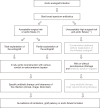Aortic Endograft Infection: Diagnosis and Management
- PMID: 37732343
- PMCID: PMC10512004
- DOI: 10.5758/vsi.230071
Aortic Endograft Infection: Diagnosis and Management
Abstract
Aortic endograft infection (AEI) is a rare but life-threatening complication of endovascular aneurysm repair (EVAR). The clinical features of AEI range from generalized weakness and mild fever to fatal aortic rupture or sepsis. The diagnosis of AEI usually depends on clinical manifestations, laboratory tests, and imaging studies. Management of Aortic Graft Infection Collaboration (MAGIC) criteria are often used to diagnose AEI. Surgical removal of the infected endograft, restoration of aortic blood flow, and antimicrobial therapy are the main components of AEI treatment. After removing an infected endograft, in situ aortic reconstruction is often performed instead of an extra-anatomic bypass. Various biological and prosthetic aortic grafts have been used in aortic reconstruction to avoid reinfection, rupture, or occlusion. Each type of graft has its own merits and disadvantages. In patients with an unacceptably high surgical risk and no evidence of an aortic fistula, conservative treatment can be an alternative. Treatment results are determined by bacterial virulence, patient status, including the presence of an aortic fistula, and hospital factors. Considering the severity of this condition, the best strategy is prevention. When encountering a patient with AEI, current practice emphasizes a multidisciplinary team approach to achieve an optimal outcome.
Keywords: Abdominal aortic aneurysm; Diagnosis; Endovascular aneurysm repair; Infections; Treatment.
Conflict of interest statement
The author has nothing to disclose.
Figures






References
-
- Argyriou C, Georgiadis GS, Lazarides MK, Georgakarakos E, Antoniou GA. Endograft infection after endovascular abdominal aortic aneurysm repair: a systematic review and meta-analysis. J Endovasc Ther. 2017;24:688–697. doi: 10.1177/1526602817722018. https://doi.org/10.1177/1526602817722018. - DOI - PubMed
-
- Verzini F, Cao P, De Rango P, Parlani G, Xanthopoulos D, Iacono G, et al. Conversion to open repair after endografting for abdominal aortic aneurysm: causes, incidence and results. Eur J Vasc Endovasc Surg. 2006;31:136–142. doi: 10.1016/j.ejvs.2005.09.016. https://doi.org/10.1016/j.ejvs.2005.09.016. - DOI - PubMed
-
- Davila VJ, Stone W, Duncan AA, Wood E, Jordan WD, Jr, Zea N, et al. A multicenter experience with the surgical treatment of infected abdominal aortic endografts. J Vasc Surg. 2015;62:877–883. doi: 10.1016/j.jvs.2015.04.440. https://doi.org/10.1016/j.jvs.2015.04.440. - DOI - PubMed
-
- Verhoeven EL, Tielliu IF, Prins TR, Zeebregts CJ, van Andringa de Kempenaer MG, Cinà CS, et al. Frequency and outcome of re-interventions after endovascular repair for abdominal aortic aneurysm: a prospective cohort study. Eur J Vasc Endovasc Surg. 2004;28:357–364. doi: 10.1016/j.ejvs.2004.06.013. https://doi.org/10.1016/j.ejvs.2004.06.013. - DOI - PubMed
-
- Back MR. In: Rutherford's vascular surgery. 8th ed. Cronenwett JL, Johnston KW, editors. Saunders; 2014. Local complications: graft infection; pp. 654–662.
Publication types
LinkOut - more resources
Full Text Sources

